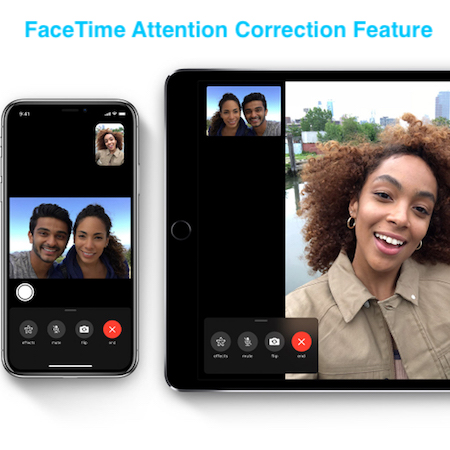Another interesting new feature coming along iOS 13 is FaceTime Attention Correction. Its role is to make FaceTime video calls more personal by artificially adjusting the set of your eyes so that it helps you to make eye contact with your caller. You probably noticed that every time you are engaged in a FaceTime video call the conversation partner/partners don’t look you directly in your eyes. Naturally, everyone looks at the iPhone’s, iPad’s or at the Mac’s screen, because they want to see what happens at the end of the line.
In order to make eye contact with the other persons, you would need to look both at the device’s camera so that the conversation partner perceives you at looking in their eyes. However, if you do this you won’t be able to see him or her because you can’t look at the same time at the iPhone’s screen and into its cameras. It’s an angle difference that prevents natural eye contact.
FaceTime Attention Correction Feature
How It Works
Starting with iOS 13 Apple has a solution for this small inadvertence. Through a combination of hardware and software improvements compatible iPhone and iPad, models are able to use the front-facing TrueDepth camera to capture an ARKit depth map and artificially “adjust” your eyesight to create the impression that you’re looking at the camera even if you are actually gazing at the iPhone’s screen.
 How To Set Up
How To Set UpThe FaceTime Attention Correction feature is optional. It’s currently not enabled by default. You can turn it on from Settings -> FaceTime -> FaceTime Attention Correction and disable it whenever you want.
Compatibility
You need to own an Apple device equipped with TrueDepth camera hardware and enough image processing power. This means that this feature is compatible with iPhone XR, iPhone XS, iPhone XS Max, and the 2018 iPad Pro models. Your device needs to run iOS 13 or later and iPadOS or later.
Fact: the FaceTime Attention Correction feature doesn’t need both participants to own compatible devices.
Debate
Ever since the announcement of this new feature, an interesting debate has started on the online forms. Is FaceTime Attention Correction actually making the conversation more personal, or it’s actually faking the way you look at your conversation partner? Will we end up in the near future video calling someone and appearing to make eye contact while doing something completely else in the background? Do you plan to use this feature or will keep it disabled?



